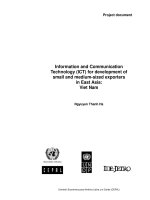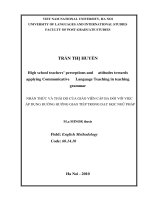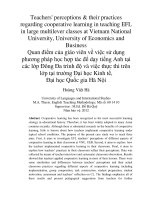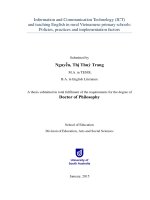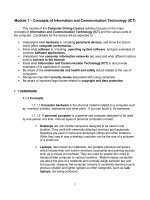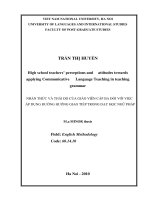Efl primary school teachers’perceptions and practices of using information and communication technology (ict) in english teaching
Bạn đang xem bản rút gọn của tài liệu. Xem và tải ngay bản đầy đủ của tài liệu tại đây (1.26 MB, 74 trang )
MINISTRY OF EDUCATION AND TRAINING
QUY NHON UNIVERSITY
NGUYỄN THỊ DUYÊN
EFL PRIMARY SCHOOL TEACHERS’
PERCEPTIONS AND PRACTICES OF USING
INFORMATION AND COMMUNICATION
TECHNOLOGY (ICT) IN ENGLISH TEACHING
Field: Theory and Methodology of English Language Teaching
Code: 8140111
SUPERVISOR: Dr. VÕ DUY ĐỨC
BỘ GIÁO DỤC- ĐÀO TẠO
TRƢỜNG ĐẠI HỌC QUY NHƠN
NGUYỄN THỊ DUYÊN
NHẬN THỨC VÀ THỰC TIỄN
VỀ VIỆC SỬ DỤNG CÔNG NGHỆ THÔNG TIN
VÀ TRUYỀN THÔNG (ICT)
TRONG DẠY TIẾNG ANH CỦA GIÁO VIÊN
TIẾNG ANH TIỂU HỌC
Ngành: Lý luận và phƣơng pháp dạy - học môn Tiếng Anh
Mã số: 8140111
NGƢỜI HƢỚNG DẪN: TS. VÕ DUY ĐỨC
i
STATEMENT OF ORIGINAL AUTHORSHIP
I hereby certify that the thesis entitled “EFL PRIMARY SCHOOL
TEACHERS‟ PERCEPTIONS AND PRACTICES OF USING
INFORMATION AND COMMUNICATION TECHNOLOGY (ICT) IN
ENGLISH TEACHING” is the result of my research. This thesis has not been
submitted to any other university or educational institution for consideration
for a degree. To the best of my knowledge, the thesis does not include any
previously published or written works by others, with the exception of the
references provided within the text.
Quy Nhon, 2023
NGUYEN THI DUYEN
ii
ACKNOWLEDGEMENTS
This thesis could not have been finished without the help of numerous
people. I want to sincerely thank and show my respect to everyone who has
given me guidance and support while I've been conducting this research.
First and foremost, I would like to sincerely thank my supervisor, Dr. Vo
Duy Duc, for his helpful guidance, insightful recommendations, and scathing
criticism that have enabled me to choose a worthy subject to work on and
complete it on schedule.
In addition, I would like to express my profound gratitude to the
professors, lecturers, and instructors of Quy Nhon University for their kind
and patient assistance in imparting valuable knowledge and assisting me with
the steps necessary to finish my degree program.
I also appreciate the English teachers in Quy Nhon city who took part in
this research. The completion of this study would not have been possible
without their r helpful contribution and co-operation.
Last but not least, I owe a special debt of gratitude to my family for their
never-ending backing and encouragement, which enabled me to finish this
study even during the toughest moments. I consider myself very fortunate to
have their support and sympathy.
iii
ABSTRACT
ICT technologies can help teachers and students because they offer a
growing number of options for improving the inputs, processes, and results of
teaching and learning in EFL classrooms. However, a number of factors
influence the use of ICT in the classroom, with instructors' perceptions being
the most important. The purpose of this study was to find out EFL primary
school teachers‟ perceptions and their practices of using ICT in language
teaching. 32 teachers answered questionnaires, five of the teachers who
completed the questionnaires were interviewed, and four classroom
observations were conducted at different primary schools in Quy Nhon city to
gather the data. The findings show that the teacher perceptions on the use of
ICT in EFL instruction and learning were generally positive. The majority of
teachers believed that ICT was an important tool due to its ability to enhance
the process of teaching and learning. However, teachers‟ lack of knowledge
and experience in ICT training, together with limited time and ICT
equipment, an unstable Internet connection, and other factors made it difficult
for them to use ICT. From these empirical findings, implications for
educators, school administrators, and EFL teachers were also provided for
better integration ICT in English Teaching.
iv
TABLE OF CONTENT
STATEMENT OF ORIGINAL AUTHORSHIP ............................................... i
ACKNOWLEDGEMENTS .............................................................................. ii
ABSTRACT ..................................................................................................... iii
TABLE OF CONTENT ................................................................................... iv
LIST OF ABBREVIATIONS .......................................................................... vi
LIST OF TABLES........................................................................................... vii
CHAPTER 1. INTRODUCTION .................................................................. 1
1.1. Rationale ................................................................................................. 1
1.2. Aim and objectives of the study ............................................................. 3
1.2.1. Aim of the study ............................................................................... 3
1.2.2. Objectives of the study ..................................................................... 3
1.3. Research questions.................................................................................. 3
1.4. Scope of the study................................................................................... 3
1.5. Significance of the study ........................................................................ 4
1.6. Structure of the study.............................................................................. 4
CHAPTER 2. LITERATURE REVIEW ...................................................... 6
2.1. Definition of ICT .................................................................................... 6
2.2. Teachers‟ perceptions ............................................................................. 7
2.2.1. Definition of teachers‟ perceptions .................................................... 7
2.2.2. Types of Perception.......................................................................... 8
2.2.3. Teachers‟ Perceptions on ICT Use................................................... 8
2.3. Teachers‟ acceptance of ICT .................................................................. 9
2.4. Benefits of using ICT............................................................................ 11
2.5. Challenges in the use of ICT ................................................................ 14
2.6. Previous studies .................................................................................... 17
2.7. Summary ............................................................................................... 20
v
CHAPTER 3. METHODOLOGY ............................................................... 21
3.1. Research approaches............................................................................. 21
3.2. Research setting and participants ......................................................... 22
3.3. Data Collection Instruments ................................................................. 24
3.3.1. Survey Questionnaires.................................................................... 24
3.3.2. Interview......................................................................................... 25
3.3.3. Classroom Observation .................................................................. 25
3.4. Data Analysis ........................................................................................ 27
3.5. Summary ............................................................................................... 27
CHAPTER 4. FINDINGS AND DISCUSSION ......................................... 29
4.1. EFL Teachers‟ perceptions about the benefits of using ICT................ 29
4.1.1. Teachers‟ perceptions about ICT usefulness for students‟ learning........29
4.1.2. Teachers‟ perceptions about ICT usefulness for teachers‟ teaching .......33
4.2. EFL Teachers‟ perceptions about difficulties in using ICT in English
teaching ........................................................................................................ 37
4.3. EFL Teachers‟ practices of using ICT in English teaching.................. 41
4.3.1. The use of ICT tools....................................................................... 41
4.3.2. Teacher‟s activities......................................................................... 42
4.3.3. Students‟ activities ......................................................................... 43
4.4. Summary ............................................................................................... 43
CHAPTER 5. CONCLUSION ..................................................................... 44
5.1. Conclusions........................................................................................... 44
5.2. Implications .......................................................................................... 46
5.3. Limitations ............................................................................................ 47
5.4. Suggestions for further studies ............................................................. 48
REFERENCES .............................................................................................. 49
APPENDICES
Abbreviation vi
ICT
EFL LIST OF ABBREVIATIONS
MOET
Full expression
Information and Communication Technology
English as a Foreign Language
Ministry of Education and Training
vii
LIST OF TABLES
Table Title Page
23
3.1 Participants‟ background information 30
4.1 Teachers‟ perceptions about ICT usefulness for students‟ 34
learning
37
4.2 Teachers‟ perceptions about ICT usefulness for teaching
English
4.3 Teachers‟ perceptions about difficulties in using ICT in
English teaching
1
CHAPTER 1. INTRODUCTION
The introduction chapter helps lay background information essential for
an understanding of the issue discussed in this study. In addition, it is
established with the framework of the thesis consisting of (1) rationale, (2)
aim and objectives, (3) research questions, (4) scope of the study, (5)
significance of the study, and (6) structure of the study.
1.1. Rationale
There are some reasons for conducting this research. First, in many
English language teaching (ELT) environments around the world, the role of
technology has rapidly evolved. The use of technology has become a trend in
the field of language education (Çakici, 2016). Asian developed countries
firmly believe that ICT is a necessary element of advanced, student-centered
teaching, and they support and encourage this belief (Albion, Tondeur,
Forkosh-Baruch, & Peeraer, 2015). As noted by Peearer and Van Petegem
(2011), the rationale for educational reform in Vietnam also points to that
direction with Directive 55 (MOET, 2008). Within the framework of the
MOET (2009) movement for friendly schools and engaged students, ICT is
seen as having a role in supporting the transformation of education into a
creative learning society. Furthermore, as part of fresh and creative
approaches to teaching and learning, Vietnamese educators were encouraged
to use ICT applications in a responsible manner (MOET, 2008).
The second reason is the significant role of teachers‟ perceptions in the
field of English language teaching. Barcelos (2003) claims that what teachers
do in the classrooms is influenced by their perceptions. Teachers' perceptions,
according to Moloi (2009), cause how teachers deal with shortcomings in
2
their teaching situations. In addition, because thought drives conduct,
investigating teachers' perceptions and beliefs helps to gain a deeper
understanding of teachers' behaviors in classrooms and guides for improving
teachers' practices (Jia, 2004). In consequence, teachers' perceptions have
played a crucial role in the teaching and learning process because they have a
huge impact on teachers' decision-making and current classroom teaching
methods, as well as providing important insight into various facets of
education. When seen from the other perspective, teachers' negative beliefs
and attitudes regarding the use of ICT are considered as a significant barrier
to its integration into the teaching and learning process (Teo, 2008). In such a
context, effectively integrating ICT into English instruction is regarded to be a
viable approach.
However, Vietnam has not caught up to other nations in terms of ICT
realization and educational performance (Cuban, Kirkpatrick, & Peck, 2001;
Dang, 2013). The low adoption of ICT in the classroom is demonstrated by
Hong's (2014) research. This is corroborated by Nguyen (2016), whose
research indicates that poor ICT use among Vietnamese language instructors
falls short of the demands of socioeconomic development, which is mostly
dependent on the expansion of global communication and services (Vu &
Burns, 2014).
All the above reasons have inspired me to choose the topic "EFL
primary school teachers' perceptions and practices of using Information
and Communication Technology (ICT) in English teaching" for my M.A
thesis. This study aims to explore teachers' perceptions towards integrating
ICT as well as their practices in English classroom. The findings of the study
are hoped to provide valuable insights and pedagogical implications for
teachers to enhance the effective implementation of using ICT.
3
1.2. Aim and objectives of the study
1.2.1. Aim of the study
This study aims to investigate EFL primary school teachers‟
perceptions and practices of using ICT in their language teaching.
1.2.2. Objectives of the study
In order to achieve this aim, the following objectives were fulfiled:
To investigate the EFL primary school teachers‟ perceptions of
the benefits of using ICT in their language teaching
To examine the EFL primary school teachers‟ perceptions of the
difficulties in using ICT in their language teaching
To explore the EFL primary school teachers‟ practices of ICT in
their language teaching
1.3. Research questions
In an attempt to achieve the above-presented aims, the study seeks to
answer the following research questions:
1. What are the EFL primary school teachers‟ perceptions of the
benefits of using ICT in their language teaching?
2. What are the EFL primary school teachers' perceptions of the
difficulties in using ICT in their language teaching?
3. What are the EFL primary school teachers‟ practices of using ICT
for their language teaching?
1.4. Scope of the study
The research was carried out with the participation of 32 English
teachers who were teaching English at 11 primary schools in Quy Nhon city,
Binh Dinh Province. This study just focused on EFL teachers‟ perceptions
4
about the benefits, the difficulties and their practices in using ICT in their
language teaching. The data was collected through the questionnaires
interviews and observations.
1.5. Significance of the study
This research is considered to be important for some reasons.
In theory, the study will be helpful in establishing a knowledge base on
teachers' perceptions of the use of ICT in the classroom by incorporating data
on ICT use in teaching English.
In actuality, the study aims to illuminate both teachers' opinions of the
advantages of ICT integration and the challenges they encounter while
implementing it in the classroom. The research's conclusions will thus offer
crucial new perspectives on how to see ICT as an efficient instructional tool
in the language teaching-learning process, which encourages teachers to
include ICT into their practices. In addition, a better understanding of EFL
teachers' challenges that teachers face may serve as a guide for different
stakeholders, i.e. policy-makers, decision-makers, educators, and ICT
theorists to design ICT policies and develop technology- based educational
programs or strategies to make learning more effective, applicable, and
enjoyable.
Finally, the findings of this research can act as a useful source of
reference for future researchers who are interested in the field of ICT in the
English teaching-learning process.
1.6. Structure of the study
The thesis will consist of five chapters.
Chapter 1, Introduction, gives a brief introduction about the
background of the research, rationale, aim and objectives, research questions,
5
scope, and significance as well as the structure of the thesis.
Chapter 2, Literature review, provides a fundamental overview of
literature surrounding ICT use in teaching foreign languages as well as
connects relevant studies to this study.
Chapter 3, Methodology, explains the research method. Firstly, it
presents the research questions and the hypotheses of the present study.
Secondly, it describes the research design and participants. Thirdly, it
introduces the research instruments used to collect data. Lastly, this chapter
comes to an end with the procedure to conduct the study and the methods of
data analysis.
Chapter 4, Findings and Discussion, illustrates and analyzes the data
collected to provide the answers to the research questions.
Chapter 5, Conclusion and Implications, makes a conclusion of the
report of the study. First, it summarizes the main findings. Then, it suggests
the research implications. Finally, the limitations of the study and the
suggestions for future research are the last part of this chapter.
6
CHAPTER 2. LITERATURE REVIEW
The purpose of this chapter is to lay the theoretical background for the
study by critically reviewing relevant authoritative studies. This chapter starts
by providing definitions of the key terms ICT as well as perceptions and then
teachers‟ acceptance of ICT is presented. The following part turns to the
review of benefits and challenges of ICT in English language teaching.
Finally, the chapter provided the previous studies worldwide and in the
Vietnam context to define the research gap to be achieved.
2.1. Definition of ICT
ICT stands for Information and Communication Technology and refers to
'the diverse set of technological tools and resources used to communicate, and to
create, disseminate, store, and manage information' (Blurton, 1999; Albirini,
2006). ICT is defined in some different ways in the context of education. The
term 'ICT' is defined as “forms of technology used for creating, displaying,
storing, manipulating, and exchanging information” (Donnelly, McGarr, &
O‟Reilly, 2011). It can relate to gear like computers, projectors, digital cameras,
and so on, as well as software like Microsoft Word and PowerPoint (Wang &
Woo, 2007). Information and Communication Technology (ICT) is nothing but
it includes computers, software, special hardware, Multimedia enabled devices
and a wide range of communications facilities. To sum up,
ICT is essentially a tool. However, in the scope of this paper, ICT is defined as
computer, and the internet-based technologies that include both generic software
applications (e.g., word processors, presentation software, email packages, web
browsers, search and download) and computer-assisted language learning
(CALL) software applications as well as useful websites for foreign language
teaching (Davies et al, 2012).
7
2.2. Teachers’ perceptions
2.2.1. Definition of teachers’ perceptions
It is believed that encouraging successful teaching requires teachers'
attitudes and perceptions. According to Bull (2011), perception is the capacity
to recognize, sense, or comprehend an object. Hoffman (2008) provided three
definitions of perception: the way you perceive or comprehend someone or
something; the ease with which you may comprehend or notice something;
and the way you use one of your senses to perceive or comprehend
something. However, according to Webster's Pocket Dictionary (2010),
perception is the capacity to use one's senses to see, hear, or become aware of
something.
Because teachers continuously observe their classrooms to gauge
students' knowledge, their opinions of a teaching strategy and/or the learning
environment can be trusted (Brown, 2007). Teachers' impressions are based on
how they understand and interpret what is happening in the classroom.
Although their views do not constitute convictions, they can influence their
beliefs, which are a group of presumptions or theories that are held consciously
or unconsciously (Borg, 2001; Bracey, 2016). According to Boulton (1997),
perceptions are the attitudes, behaviors, self-beliefs, and/or viewpoints that an
individual has formed toward anything. The perceptions or attitudes of teachers
are seen as being crucial in implementing effective teaching. In other words,
perception is the capacity of the total stimulus process to react once something
has been seen and understood (Diniah, 2013). According to Pajares (1992),
teachers' perceptions are closely related to teachers' beliefs. Furthermore,
Kurniawati (2006) claims that teachers' beliefs can be used to learn more about
their classroom practice and ideals. As a result, teachers must be aware of their
own beliefs about the teaching and learning process.
8
According to some of the above explanations, perception is the way
that one thinks about or understands someone or something. The term
"English teachers' perceptions" in this study refers to EFL teachers' opinions
of the use of ICT in their language teaching. Teachers' perceptions are
important in the teaching and learning process because they not only affect
teachers' behavior and decision-making, but they also offer crucial insights
into many elements of education.
2.2.2. Types of Perception
According to Irwanto (2002), there are two types of perception which
result from the interaction between person and object. They are negative and
positive perceptions, and the following description explains both of them:
1. Positive perceptions: It is a perception that describes all information
and responses positively. Besides, someone who has a positive perception will
accept and support the object that is perceived.
2. Negative perceptions: This type of perception includes all
information and responses that are in conflict with the perceived object.
It can be stated that a person's perception, both positive and negative,
will always influence how they carry out an action. And how a person defines
his full understanding of an observed thing is wholly responsible for the
development of a positive or negative perspective.
2.2.3. Teachers’ Perceptions on ICT Use
According to Hepp, Hinostraza, Laval, and Rehpain (2004), the
adoption rate of ICT is influenced by teachers' attitudes and ideas about it.
Indeed, they note that those who see the potential of ICT will rapidly
investigate technologies in their work and consider computers to be "valuable
tools" and "useful" (Hepp et. al, 2004).
9
Regarding positive perceptions, teachers are more likely to incorporate
ICT into their lessons if they believe the training was useful (Galanouli,
Murphy, & Gardner, 2004). Their impression that technology can bring about
innovation, such as an impact on higher thinking skill and on content
acquisition for language learners, is another factor contributing to their
openness toward potential technological improvements (Baylor & Ritchie,
2002). Cope and Ward (2002) also discovered that instructors' perceptions of
technology include "how" and "what" affects it can have on pupils, such as
whether or not they can directly interact with computers and use specialized
software to alter language. Teachers can also recognize how technology has
the ability to inspire kids.
On the other hand, instructors' negative perceptions highlight ICT usage
limitations. According to many studies (William et al., 2000; Leaks, 2001;
Samuel & Bakar, 2003; Pelgrum, 2001), these issues typically entail a lack of
resources (facilities, expertise, time, support, materials, and training). For
instance, Pelgrum (2001), who explicitly examined perspectives of
educational practitioners from schools in 26 countries, discovered that a lack
of infrastructure, such as an inadequate number of computers, was the most
common issue. Although teachers may be aware of how to use ICT in the
classroom, a lack of computers may hinder them from doing so. Additionally,
a lack of resources may also signify a lack of access. Users may experience
difficulty accessing the small number of computers because they are
frequently booked (Samuel & Bakar, 2005).
2.3. Teachers’ acceptance of ICT
David, Bagozzi, and Warshaw (1989) proposed the Technology
Acceptance Model (TAM), which states that four aspects determine an
individual's desire to use technology: perceived usefulness (U), perceived
10
ease of use (EoU), attitude toward utilizing (A), and behavioral intention to
use (B).
According to Davis et al. (1989), perceived usefulness (U) measures
consumers' approval of utilizing a particular item because they believe it will
improve their performance. Users are aware of the advantages that the product
they use has to provide, both to other users and to themselves. A user is more
likely to employ a technological tool if he feels that it will improve his
performance. A teacher may believe that if he employs ICT in the classroom,
it will improve his performance. This encourages him to agree to the use of
technology in the classroom.
The degree to which users believe the target system to be effort-free is
determined by perceived ease of use (EoU) (Lederer et al., 2007). The
literature points out that both technical and non-technical factors can
contribute to a technology's usability issues. Teachers may encounter
technical issues such as insufficient electrical support, limited Internet
connectivity, equipment shortages, or other issues. However, instructors may
also be unwilling to use ICT because they believe the pedagogical approach to
teaching is inappropriate for them or because they are unable to handle the
system or the classroom. These circumstances lead educators to feel that
utilizing technology requires a lot of work, which lowers their enthusiasm for
its adoption.
Moreover, attitude toward usage (A) can be seen as the user's assessment
of the value of using a specific information systems application. This has to
do with how people feel about using a specific piece of technology. A teacher
may use ICT in the classroom if he has a good attitude toward it. A teacher
may refrain from using ICT if he has negative feelings about it.
11
Lastly, behavioral intention to use (B) highlights the probability that an
individual will utilize a technological application (Lederer et al., 2000). A
user is more likely to utilize ICT in the future when he has a pleasant
experience with its implementation, and vice versa.
The Technology Acceptance Model (TAM) theory has been chosen as the
conceptual framework for this research because it is pertinent to the
investigation of teachers' perspectives of using ICT in their language
instruction. Although this theory was introduced in 1989 and revised several
times, the two factors, namely perceived usefulness and perceived ease of use
are still valid in understanding the use of technology. The Technology
Acceptance Model (TAM) is a widely used framework for predicting the
adoption of information technology and is thought to be one of the most
significant models of technology acceptance. They concentrate on how
adoption intentions are impacted by opinions about how convenient and
useful technology is (Luarn and Lin, 2005; Lai & Zainal, 2015). Furthermore,
TAM was created expressly to address the aspects of users' acceptance of
system technology (Chau & Hu, 2002). Thus, it is favorable for examining
challenges referred to as external variables in TAM.
2.4. Benefits of using ICT
In today's technologically advanced world, ICT integration in education
is defined by the use of technology tools to support teaching and learning
activities. ICT integration in schools, especially in classrooms, is a crucial
component since learners are comfortable with technology and will learn
better in a technology-based setting. There is no doubt that ICT is a useful and
cutting-edge teaching instrument that has a good impact on all facets of the
language-learning process.
